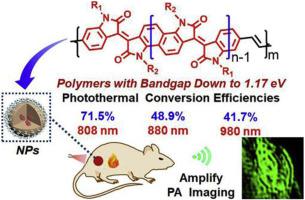Biomaterials ( IF 12.8 ) Pub Date : 2020-06-10 , DOI: 10.1016/j.biomaterials.2020.120179 Yu Jiang 1 , Xingchen Duan 2 , Junhua Bai 3 , Hongkun Tian 4 , Dan Ding 2 , Yanhou Geng 1

|
Photothermal conversion nanoagents based on conjugated polymers (CPs) are attracting increasing attention for in vivo disease theranostics and high-performing ones are in urgent pursuit. Herein, we report a new and non-donor-acceptor approach to photothermal conversion CPs that combine several merits including low bandgaps, strong near-infrared absorption, low intersystem crossing rate and non-emissive nature. Three CPs based on 6,7; 6′,7′-fused isoindigos (nIIDs), i.e., P2IIDV, P3IIDV and P4IIDV that have optical bandgaps of 1.30, 1.22 and 1.17 eV, respectively, are synthesized. The nanoparticles (NPs) of the CPs in water are prepared via nanocoprecipitation, which are non-fluorescent due to the rapid intramolecular twisting in the CP backbone within NPs, enabling most of the excitation energy flow to generate heat. The photothermal conversion efficiencies of the NPs as measured under irradiation at 808, 880 and 980 nm are 62.4%, 40.5% and 15.8% for P2IIDV, 65.1%, 41.0% and 38.9% for P3IIDV and 71.5%, 48.9% and 41.7% for P4IIDV, which are significantly higher than indocyanine green and many popularly reported photothermal conversion materials. In vivo studies using xenograft 4T1 tumor-bearing mouse model demonstrate that the P4IIDV NPs can serve as a rather effective photothermal conversion nanoagent for enhanced photoacoustic imaging and photothermal therapy of tumors.
中文翻译:

聚合诱导的光热疗法:一种高效的近红外光热转化纳米粒子的非供体受体方法。
基于共轭聚合物(CPs)的光热转化纳米剂在体内疾病治疗中的应用日益受到关注,高性能的纳米药物正在紧锣密鼓地追求中。本文中,我们报告了一种新的,非供体受体的光热转换CP方法,该方法结合了多个优点,包括低带隙,强大的近红外吸收,低的系统间交叉速率和非发射性质。基于6,7的三个CP;合成了分别具有1.30、1.22和1.17 eV的光学带隙的6',7'-融合的靛蓝(nIIDs),即P2IIDV,P3IIDV和P4IIDV。水中CPs的纳米颗粒(NPs)是通过纳米共沉淀法制备的,由于NPs中CP骨架中分子内的快速分子内扭曲,使得它们不发荧光,从而使大部分激发能流产生热量。在808、880和980 nm照射下测得的NP的光热转换效率分别为P2IIDV为62.4%,40.5%和15.8%,P3IIDV为65.1%,41.0%和38.9%,P3IIDV为71.5%,48.9%和41.7% P4IIDV,其显着高于吲哚菁绿和许多流行报道的光热转换材料。使用异种移植4T1荷瘤小鼠模型的体内研究表明,P4IIDV NP可作为相当有效的光热转化纳米剂,用于增强肿瘤的光声成像和光热疗法。其显着高于吲哚菁绿和许多流行报道的光热转换材料。使用异种移植4T1荷瘤小鼠模型的体内研究表明,P4IIDV NP可作为相当有效的光热转化纳米剂,用于增强肿瘤的光声成像和光热疗法。其显着高于吲哚菁绿和许多流行报道的光热转换材料。使用异种移植4T1荷瘤小鼠模型的体内研究表明,P4IIDV NP可作为相当有效的光热转化纳米剂,用于增强肿瘤的光声成像和光热疗法。











































 京公网安备 11010802027423号
京公网安备 11010802027423号